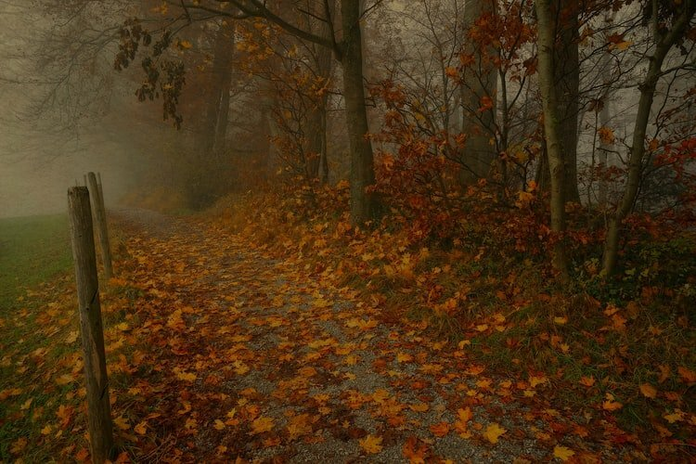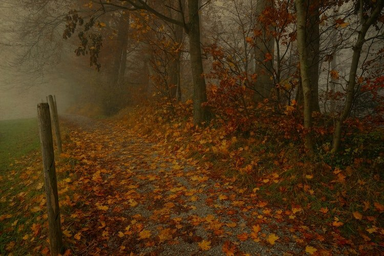In just ten short 10-minute episodes, how could a cartoon possibly manage to build a fantasy world so familiar—yet so unknown— that it causes viewers to feel homesick for a place they have never been? Ask Patrick McHale, the genius behind Emmy-award winning miniseries Over the Garden Wall (OTGW). When his show originally aired on Cartoon Network in 2014, it was immediately–– and unsurprisingly–– met with positive viewer ratings and critical acclaim. By expertly balancing whimsy and malice, this charming cult classic packs a punch: the storyline thrusts viewers into an immersive autumnal dreamscape with lovable, relatable characters and a warm, vintage-inspired art style. Juxtaposed with its underbelly of haunting topics like mortality and manipulation, this show boasts a level of maturity that is unparalleled in children’s media.
Over the Garden Wall follows Greg and Wirt, a pair of half-brothers who find themselves lost in the woods with no memory of how they got there. With Greg fulfilling the role of perpetually wide-eyed child and Wirt being a melodramatic, insecure, and serious teenage sibling, the two often butt heads and cause themselves more trouble than necessary. Throughout their journey, they outwit a series of minor antagonists, yet The Beast— an unidentifiable, manipulative monster who is driven solely by self-preservation— consistently looms in the brothers’ shadows, waiting for their moment of weakness. In this dark-fantasy-meets-comedy, Greg and Wirt travel deeper into the woods to avoid The Beast’s evil grasp, and enlist various comedic creatures of The Unknown to help them find their way back home. OTGW is so wildly successful among viewers because it satisfies a specific niche: the desire for a balance between grimly gothic and endearingly comforting. This success can be directly attributed to its strategic production context, broad variety of nostalgic appeals, allusions to classic folktales, and cohesive technical & aesthetic elements.
OTGW is a unique product of the post-network television era, as the entire show only ran for less than a week in 2014. From November 3rd to the 7th, two 10-minute episodes were put on air every night for five nights until the entire series was complete. This timeframe was not only intentional, but a genius tactic to lure in viewers. OTGW is known for its cozy autumnal ambience, including imagery of warm light, pumpkins, folksy pilgrim towns, and falling leaves from lush orange-and-yellow treetops. Combined with its horror-based elements that perfectly align with the Halloween-esque desire for fright, such as the grotesque Beast [see right photo], mid-fall was ideal for OTGW’s original release. The series tackles themes of transformation, life cycles, death, and maturity— which are all understood as universal literary characteristics of fall. Likewise, it is revealed in “Chapter 9: Into the Unknown” that Greg and Wirt actually began their journey on October 31st. This meaningful, strategic debut ensured that OTGW’s initial viewers would feel truly immersed in the world Patrick McHale built.
As for cultural context: the miniseries was fortunate enough to premiere during the peak of digital culture as we know it: the 2014 Tumblr fandom era. Animated shows such as Steven Universe, Gravity Falls, and My Little Pony: Friendship is Magic were especially popular at this time and garnered massive online communities. Thus, it was no surprise that OTGW was an immediate contender for a fanbase on Tumblr’s highly lucrative platform. With its strategic release during Tumblr’s fandom craze and obsession with animated media, Cartoon Network understood that Over the Garden Wall was a recipe for success. Thousands of OTGW-devoted Tumblr blogs were created, prompting an increased quantity of online discussion, fanart, speculative theories, cosplays, and an overwhelming atmosphere of support and admiration for the show.
What is so unique about OTGW in comparison to its adjacent fandoms is that other online communities mostly existed as intense, short-lived obsessions that burnt out in direct correlation with Tumblr’s decline in users over the years. Over the Garden Wall’s initial November release allowed it to withstand the test of time, since long-term viewers immediately associate the season of fall with the show’s autumnal imagery. Thus, it regains online popularity every September through December, each year recruiting new viewers as the positive buzz shows up on social media once more. Because of this, it is widely regarded to be the internet’s Halloween tradition. To summarize, a show becomes harder to lose value if viewers only indulge in it once a year, making it a highly anticipated, nostalgic, and ceremonial watch.
Another crucial element of its successful production is that the first (and only) season takes a mere 90 minutes to complete from start to finish. At the simplest level, this is a perk in that it makes the show incredibly digestible for its viewers. This speedy runtime is unique for any series, but especially so for a Cartoon Network program— a channel that is notorious for dragging out popular shows until they feel redundant, lower in quality, and excessively commercialized. OTGW never feels inauthentic or low quality despite being children’s media. The finite, self-contained nature of this program allows each episode (charmingly referred to as “Chapters”) to feel like a precious, timeless fairytale. The beloved story can’t be tainted posthumously or ruined with a horrible money-grabbing second season. This provides a sense of comfort and stability to those who rewatch it every year. Such genius formatting also allows the ending to be left as an unanswered mystery open to personal interpretation, which forces the audience to constantly think about the what-if’s of the show’s unanswered aspects.
At its core, Over the Garden Wall is a coming-of-age story about the growth of two brothers; it perfectly balances the sobering, eerie elements of a mystery with the comforting, homesick nature of a classic cartoon. This 2014 miniseries offers a new way of looking at the traditional hero’s journey. Much like a favorite old sweater that’s scratchy and holey and tattered from years of age, it leaves you feeling exposed and vulnerable when worn in public, yet warm and sentimental while in the company of only your own reflection. Over the Garden Wall is the rare kind of sweater that you gingerly pull from storage every autumn, and it will truly never feel stale or outgrown.


